Market Research Proposal: Yoga Social Enterprise in Cambodia
VerifiedAdded on 2023/06/08
|20
|4233
|198
Report
AI Summary
This report presents a market research proposal for establishing a Yoga Social Enterprise in Kampot, Cambodia, aimed at supporting social development. It identifies key products and services to attract tourists, analyzes push and pull campaign parameters, and provides recommendations for campaign success. The research explores the potential of yoga tourism to address social disparities and promote well-being, particularly among disadvantaged populations. The study utilizes various research objectives and hypothesis to analyze the potential yoga market and retreat strategies of Kampot, Cambodia and the ways in which the valuable retreat can be used for the success of the brand both in national and international level. The proposal includes a literature review, methodology, and questionnaire for data collection, emphasizing the commercial feasibility and social impact of the enterprise.
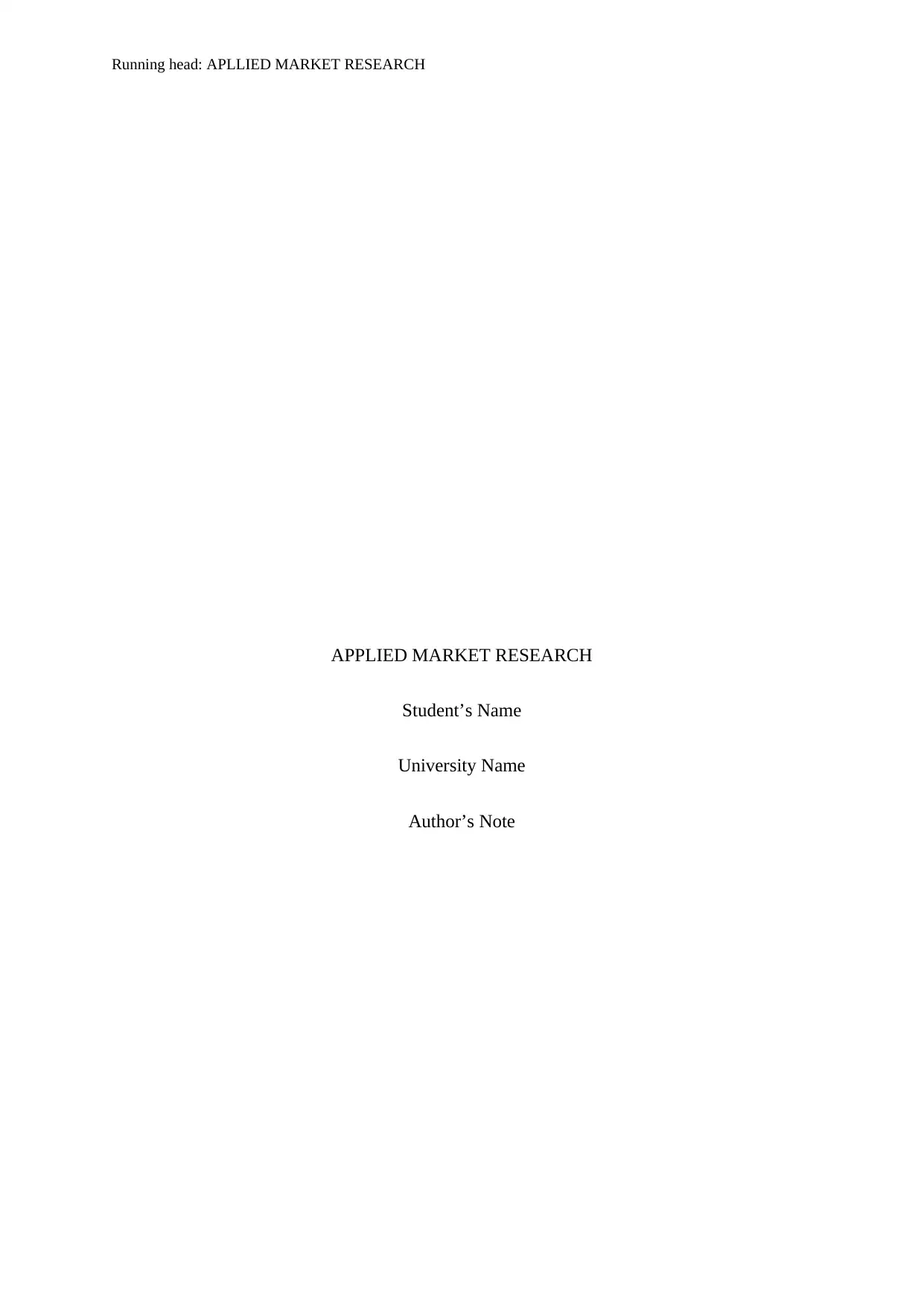
Running head: APLLIED MARKET RESEARCH
APPLIED MARKET RESEARCH
Student’s Name
University Name
Author’s Note
APPLIED MARKET RESEARCH
Student’s Name
University Name
Author’s Note
Paraphrase This Document
Need a fresh take? Get an instant paraphrase of this document with our AI Paraphraser
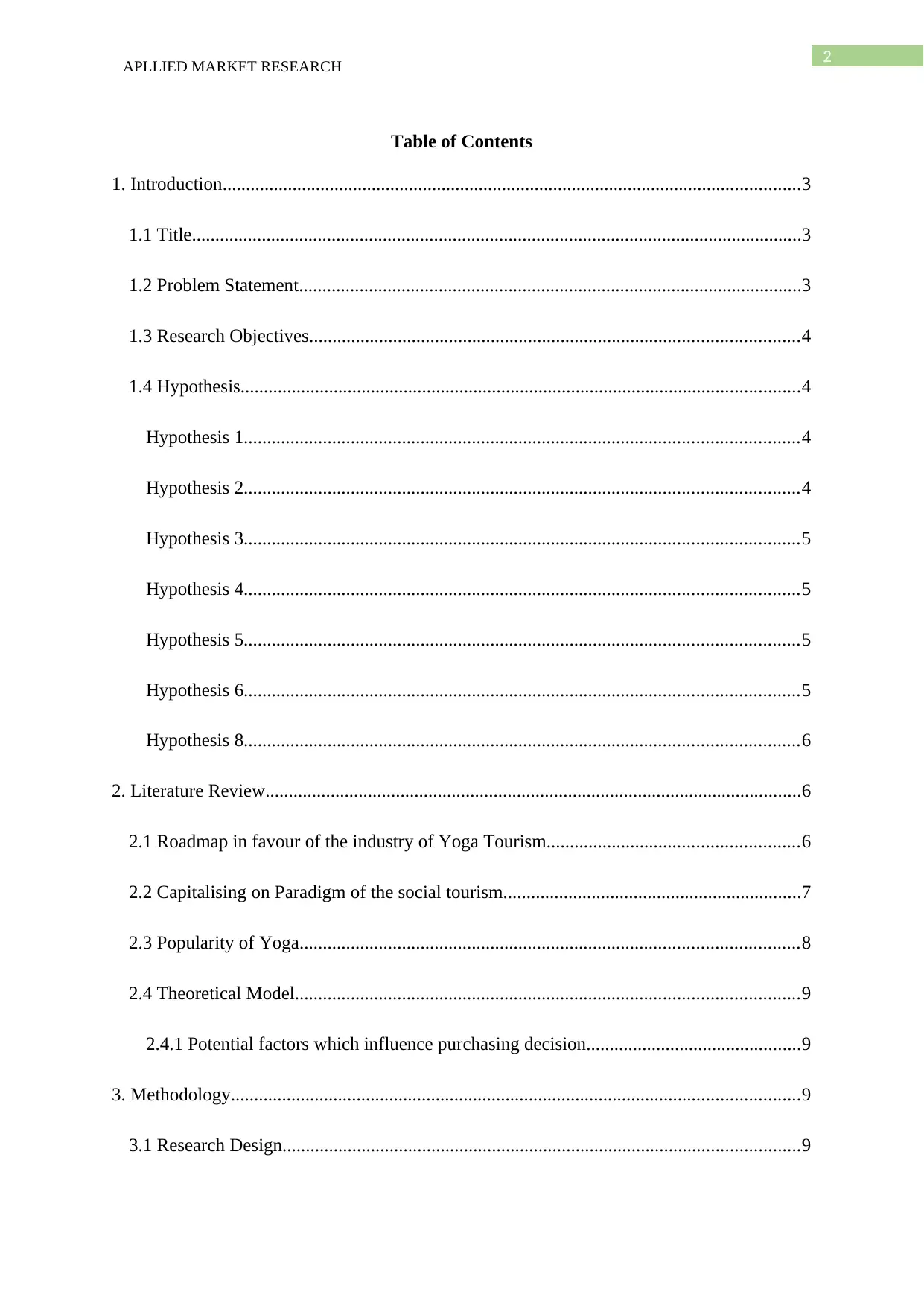
2
APLLIED MARKET RESEARCH
Table of Contents
1. Introduction............................................................................................................................3
1.1 Title...................................................................................................................................3
1.2 Problem Statement............................................................................................................3
1.3 Research Objectives.........................................................................................................4
1.4 Hypothesis........................................................................................................................4
Hypothesis 1.......................................................................................................................4
Hypothesis 2.......................................................................................................................4
Hypothesis 3.......................................................................................................................5
Hypothesis 4.......................................................................................................................5
Hypothesis 5.......................................................................................................................5
Hypothesis 6.......................................................................................................................5
Hypothesis 8.......................................................................................................................6
2. Literature Review...................................................................................................................6
2.1 Roadmap in favour of the industry of Yoga Tourism......................................................6
2.2 Capitalising on Paradigm of the social tourism................................................................7
2.3 Popularity of Yoga...........................................................................................................8
2.4 Theoretical Model............................................................................................................9
2.4.1 Potential factors which influence purchasing decision..............................................9
3. Methodology..........................................................................................................................9
3.1 Research Design...............................................................................................................9
APLLIED MARKET RESEARCH
Table of Contents
1. Introduction............................................................................................................................3
1.1 Title...................................................................................................................................3
1.2 Problem Statement............................................................................................................3
1.3 Research Objectives.........................................................................................................4
1.4 Hypothesis........................................................................................................................4
Hypothesis 1.......................................................................................................................4
Hypothesis 2.......................................................................................................................4
Hypothesis 3.......................................................................................................................5
Hypothesis 4.......................................................................................................................5
Hypothesis 5.......................................................................................................................5
Hypothesis 6.......................................................................................................................5
Hypothesis 8.......................................................................................................................6
2. Literature Review...................................................................................................................6
2.1 Roadmap in favour of the industry of Yoga Tourism......................................................6
2.2 Capitalising on Paradigm of the social tourism................................................................7
2.3 Popularity of Yoga...........................................................................................................8
2.4 Theoretical Model............................................................................................................9
2.4.1 Potential factors which influence purchasing decision..............................................9
3. Methodology..........................................................................................................................9
3.1 Research Design...............................................................................................................9
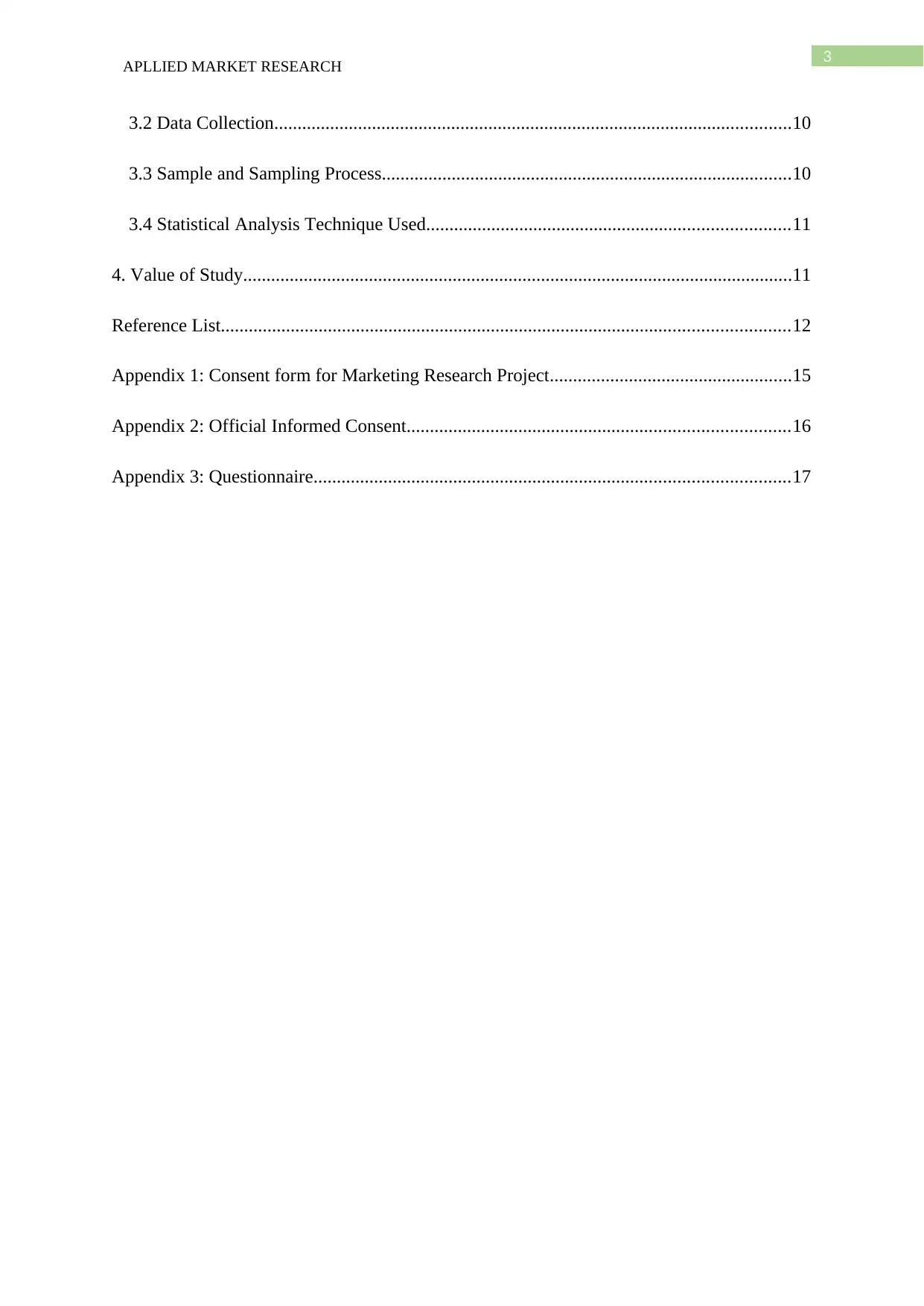
3
APLLIED MARKET RESEARCH
3.2 Data Collection...............................................................................................................10
3.3 Sample and Sampling Process........................................................................................10
3.4 Statistical Analysis Technique Used..............................................................................11
4. Value of Study......................................................................................................................11
Reference List..........................................................................................................................12
Appendix 1: Consent form for Marketing Research Project....................................................15
Appendix 2: Official Informed Consent..................................................................................16
Appendix 3: Questionnaire......................................................................................................17
APLLIED MARKET RESEARCH
3.2 Data Collection...............................................................................................................10
3.3 Sample and Sampling Process........................................................................................10
3.4 Statistical Analysis Technique Used..............................................................................11
4. Value of Study......................................................................................................................11
Reference List..........................................................................................................................12
Appendix 1: Consent form for Marketing Research Project....................................................15
Appendix 2: Official Informed Consent..................................................................................16
Appendix 3: Questionnaire......................................................................................................17
⊘ This is a preview!⊘
Do you want full access?
Subscribe today to unlock all pages.

Trusted by 1+ million students worldwide
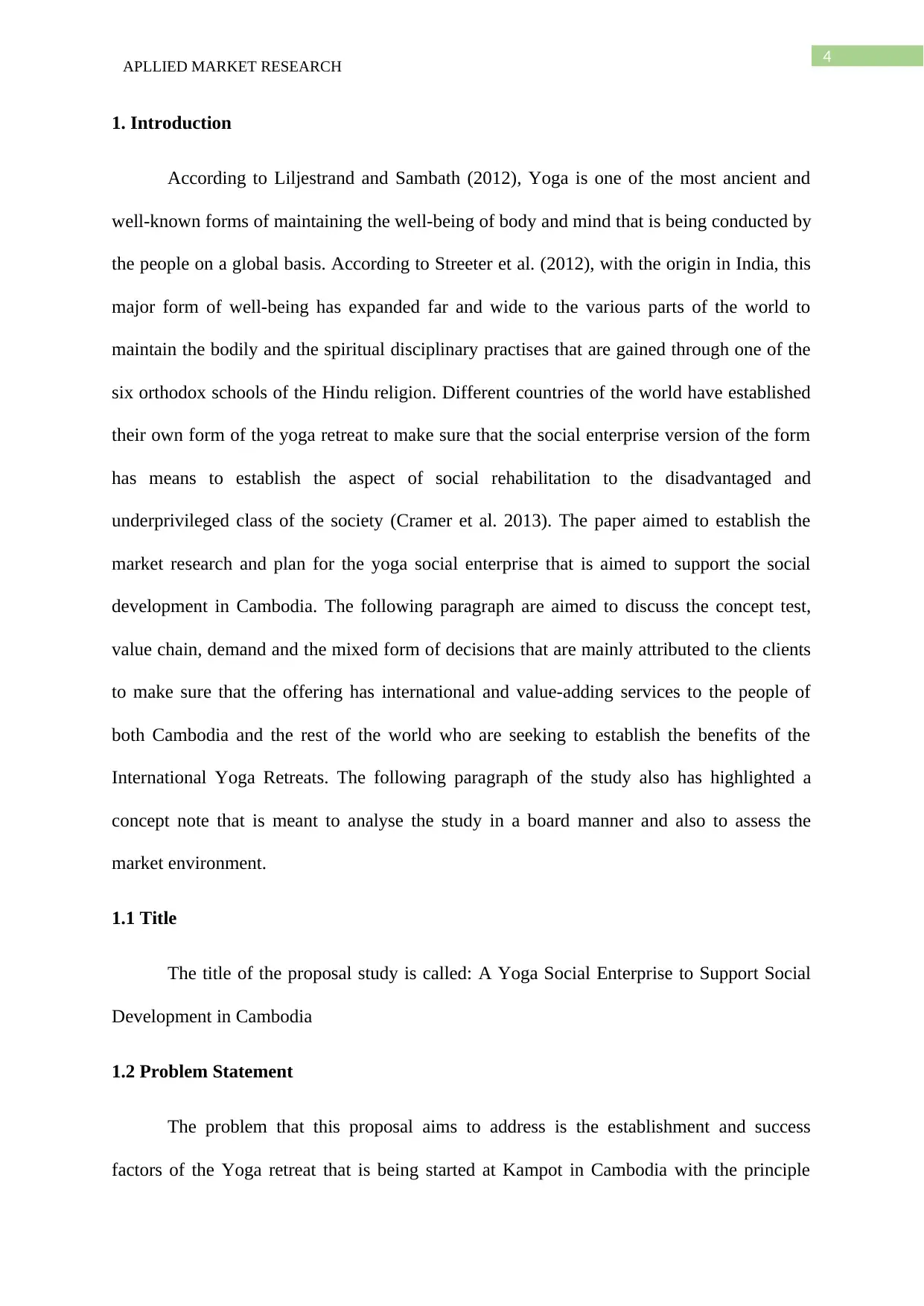
4
APLLIED MARKET RESEARCH
1. Introduction
According to Liljestrand and Sambath (2012), Yoga is one of the most ancient and
well-known forms of maintaining the well-being of body and mind that is being conducted by
the people on a global basis. According to Streeter et al. (2012), with the origin in India, this
major form of well-being has expanded far and wide to the various parts of the world to
maintain the bodily and the spiritual disciplinary practises that are gained through one of the
six orthodox schools of the Hindu religion. Different countries of the world have established
their own form of the yoga retreat to make sure that the social enterprise version of the form
has means to establish the aspect of social rehabilitation to the disadvantaged and
underprivileged class of the society (Cramer et al. 2013). The paper aimed to establish the
market research and plan for the yoga social enterprise that is aimed to support the social
development in Cambodia. The following paragraph are aimed to discuss the concept test,
value chain, demand and the mixed form of decisions that are mainly attributed to the clients
to make sure that the offering has international and value-adding services to the people of
both Cambodia and the rest of the world who are seeking to establish the benefits of the
International Yoga Retreats. The following paragraph of the study also has highlighted a
concept note that is meant to analyse the study in a board manner and also to assess the
market environment.
1.1 Title
The title of the proposal study is called: A Yoga Social Enterprise to Support Social
Development in Cambodia
1.2 Problem Statement
The problem that this proposal aims to address is the establishment and success
factors of the Yoga retreat that is being started at Kampot in Cambodia with the principle
APLLIED MARKET RESEARCH
1. Introduction
According to Liljestrand and Sambath (2012), Yoga is one of the most ancient and
well-known forms of maintaining the well-being of body and mind that is being conducted by
the people on a global basis. According to Streeter et al. (2012), with the origin in India, this
major form of well-being has expanded far and wide to the various parts of the world to
maintain the bodily and the spiritual disciplinary practises that are gained through one of the
six orthodox schools of the Hindu religion. Different countries of the world have established
their own form of the yoga retreat to make sure that the social enterprise version of the form
has means to establish the aspect of social rehabilitation to the disadvantaged and
underprivileged class of the society (Cramer et al. 2013). The paper aimed to establish the
market research and plan for the yoga social enterprise that is aimed to support the social
development in Cambodia. The following paragraph are aimed to discuss the concept test,
value chain, demand and the mixed form of decisions that are mainly attributed to the clients
to make sure that the offering has international and value-adding services to the people of
both Cambodia and the rest of the world who are seeking to establish the benefits of the
International Yoga Retreats. The following paragraph of the study also has highlighted a
concept note that is meant to analyse the study in a board manner and also to assess the
market environment.
1.1 Title
The title of the proposal study is called: A Yoga Social Enterprise to Support Social
Development in Cambodia
1.2 Problem Statement
The problem that this proposal aims to address is the establishment and success
factors of the Yoga retreat that is being started at Kampot in Cambodia with the principle
Paraphrase This Document
Need a fresh take? Get an instant paraphrase of this document with our AI Paraphraser
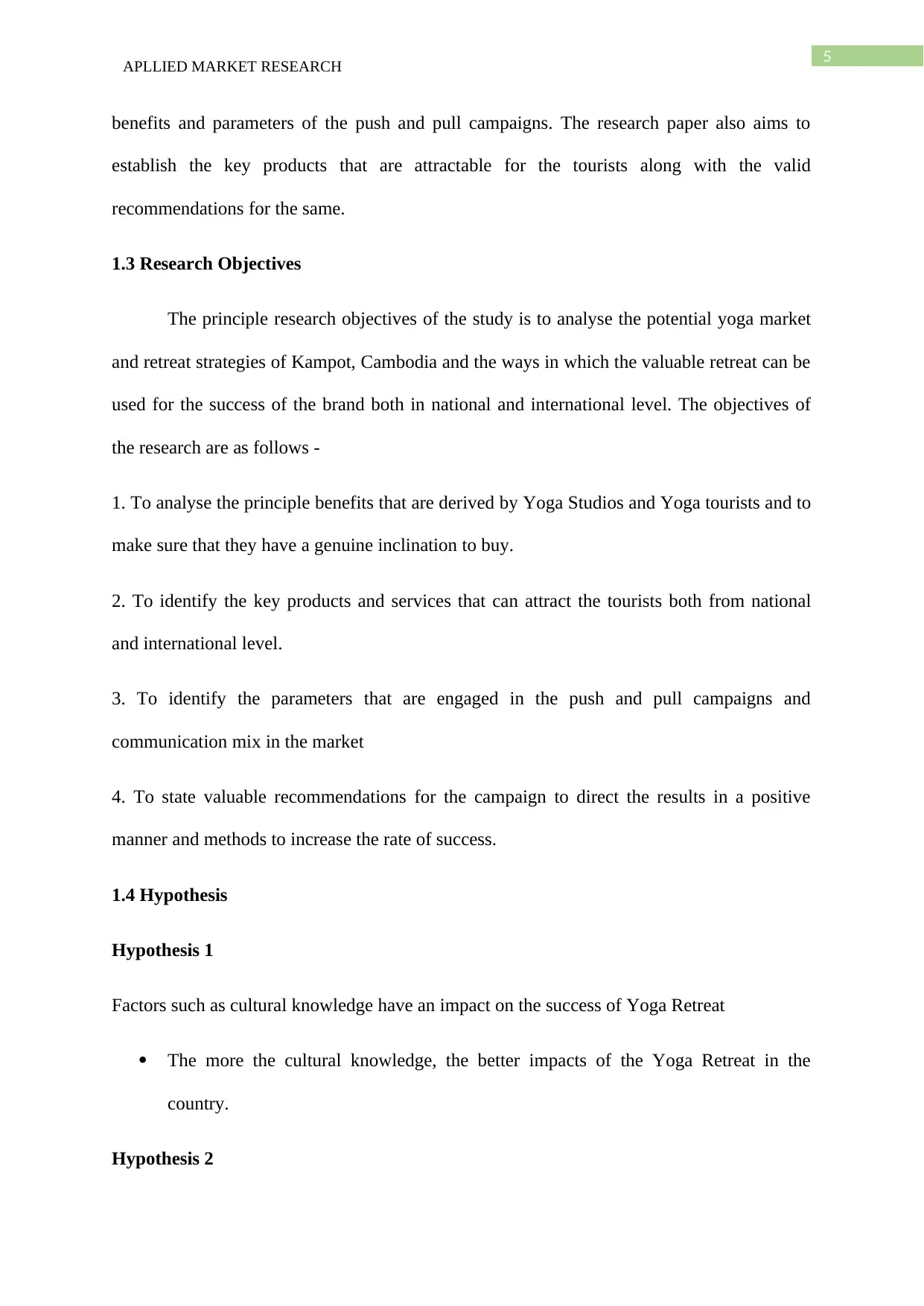
5
APLLIED MARKET RESEARCH
benefits and parameters of the push and pull campaigns. The research paper also aims to
establish the key products that are attractable for the tourists along with the valid
recommendations for the same.
1.3 Research Objectives
The principle research objectives of the study is to analyse the potential yoga market
and retreat strategies of Kampot, Cambodia and the ways in which the valuable retreat can be
used for the success of the brand both in national and international level. The objectives of
the research are as follows -
1. To analyse the principle benefits that are derived by Yoga Studios and Yoga tourists and to
make sure that they have a genuine inclination to buy.
2. To identify the key products and services that can attract the tourists both from national
and international level.
3. To identify the parameters that are engaged in the push and pull campaigns and
communication mix in the market
4. To state valuable recommendations for the campaign to direct the results in a positive
manner and methods to increase the rate of success.
1.4 Hypothesis
Hypothesis 1
Factors such as cultural knowledge have an impact on the success of Yoga Retreat
The more the cultural knowledge, the better impacts of the Yoga Retreat in the
country.
Hypothesis 2
APLLIED MARKET RESEARCH
benefits and parameters of the push and pull campaigns. The research paper also aims to
establish the key products that are attractable for the tourists along with the valid
recommendations for the same.
1.3 Research Objectives
The principle research objectives of the study is to analyse the potential yoga market
and retreat strategies of Kampot, Cambodia and the ways in which the valuable retreat can be
used for the success of the brand both in national and international level. The objectives of
the research are as follows -
1. To analyse the principle benefits that are derived by Yoga Studios and Yoga tourists and to
make sure that they have a genuine inclination to buy.
2. To identify the key products and services that can attract the tourists both from national
and international level.
3. To identify the parameters that are engaged in the push and pull campaigns and
communication mix in the market
4. To state valuable recommendations for the campaign to direct the results in a positive
manner and methods to increase the rate of success.
1.4 Hypothesis
Hypothesis 1
Factors such as cultural knowledge have an impact on the success of Yoga Retreat
The more the cultural knowledge, the better impacts of the Yoga Retreat in the
country.
Hypothesis 2
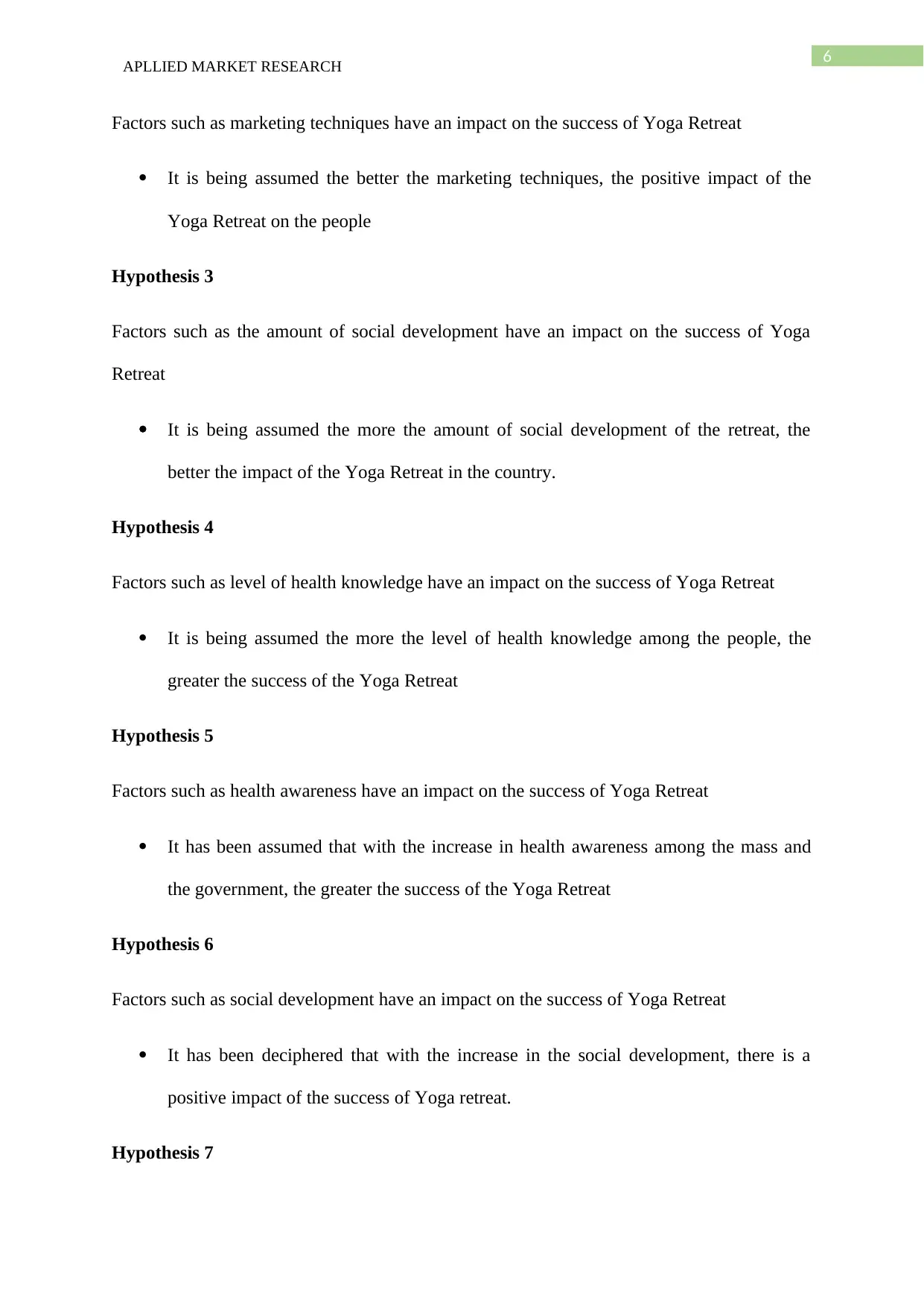
6
APLLIED MARKET RESEARCH
Factors such as marketing techniques have an impact on the success of Yoga Retreat
It is being assumed the better the marketing techniques, the positive impact of the
Yoga Retreat on the people
Hypothesis 3
Factors such as the amount of social development have an impact on the success of Yoga
Retreat
It is being assumed the more the amount of social development of the retreat, the
better the impact of the Yoga Retreat in the country.
Hypothesis 4
Factors such as level of health knowledge have an impact on the success of Yoga Retreat
It is being assumed the more the level of health knowledge among the people, the
greater the success of the Yoga Retreat
Hypothesis 5
Factors such as health awareness have an impact on the success of Yoga Retreat
It has been assumed that with the increase in health awareness among the mass and
the government, the greater the success of the Yoga Retreat
Hypothesis 6
Factors such as social development have an impact on the success of Yoga Retreat
It has been deciphered that with the increase in the social development, there is a
positive impact of the success of Yoga retreat.
Hypothesis 7
APLLIED MARKET RESEARCH
Factors such as marketing techniques have an impact on the success of Yoga Retreat
It is being assumed the better the marketing techniques, the positive impact of the
Yoga Retreat on the people
Hypothesis 3
Factors such as the amount of social development have an impact on the success of Yoga
Retreat
It is being assumed the more the amount of social development of the retreat, the
better the impact of the Yoga Retreat in the country.
Hypothesis 4
Factors such as level of health knowledge have an impact on the success of Yoga Retreat
It is being assumed the more the level of health knowledge among the people, the
greater the success of the Yoga Retreat
Hypothesis 5
Factors such as health awareness have an impact on the success of Yoga Retreat
It has been assumed that with the increase in health awareness among the mass and
the government, the greater the success of the Yoga Retreat
Hypothesis 6
Factors such as social development have an impact on the success of Yoga Retreat
It has been deciphered that with the increase in the social development, there is a
positive impact of the success of Yoga retreat.
Hypothesis 7
⊘ This is a preview!⊘
Do you want full access?
Subscribe today to unlock all pages.

Trusted by 1+ million students worldwide
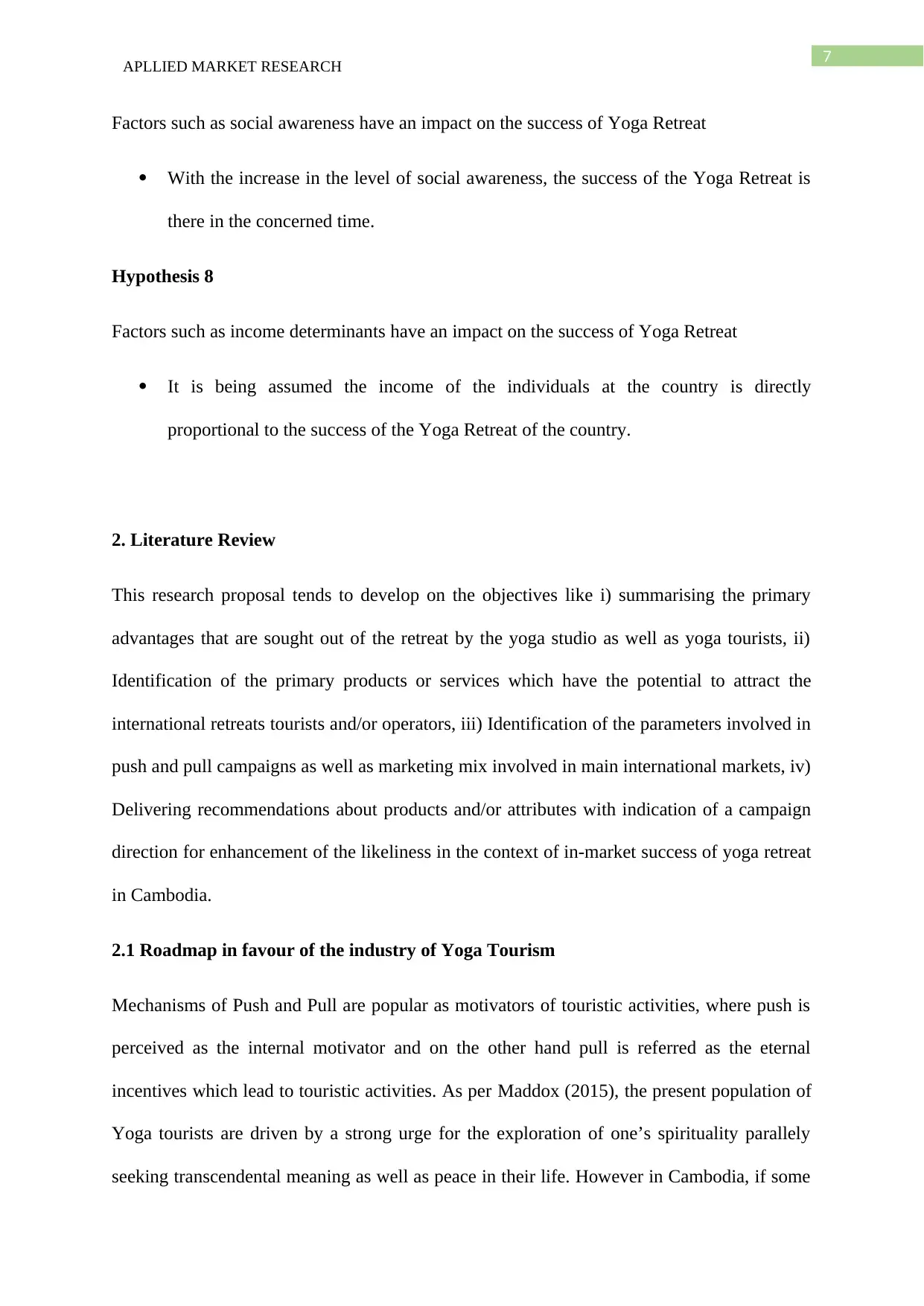
7
APLLIED MARKET RESEARCH
Factors such as social awareness have an impact on the success of Yoga Retreat
With the increase in the level of social awareness, the success of the Yoga Retreat is
there in the concerned time.
Hypothesis 8
Factors such as income determinants have an impact on the success of Yoga Retreat
It is being assumed the income of the individuals at the country is directly
proportional to the success of the Yoga Retreat of the country.
2. Literature Review
This research proposal tends to develop on the objectives like i) summarising the primary
advantages that are sought out of the retreat by the yoga studio as well as yoga tourists, ii)
Identification of the primary products or services which have the potential to attract the
international retreats tourists and/or operators, iii) Identification of the parameters involved in
push and pull campaigns as well as marketing mix involved in main international markets, iv)
Delivering recommendations about products and/or attributes with indication of a campaign
direction for enhancement of the likeliness in the context of in-market success of yoga retreat
in Cambodia.
2.1 Roadmap in favour of the industry of Yoga Tourism
Mechanisms of Push and Pull are popular as motivators of touristic activities, where push is
perceived as the internal motivator and on the other hand pull is referred as the eternal
incentives which lead to touristic activities. As per Maddox (2015), the present population of
Yoga tourists are driven by a strong urge for the exploration of one’s spirituality parallely
seeking transcendental meaning as well as peace in their life. However in Cambodia, if some
APLLIED MARKET RESEARCH
Factors such as social awareness have an impact on the success of Yoga Retreat
With the increase in the level of social awareness, the success of the Yoga Retreat is
there in the concerned time.
Hypothesis 8
Factors such as income determinants have an impact on the success of Yoga Retreat
It is being assumed the income of the individuals at the country is directly
proportional to the success of the Yoga Retreat of the country.
2. Literature Review
This research proposal tends to develop on the objectives like i) summarising the primary
advantages that are sought out of the retreat by the yoga studio as well as yoga tourists, ii)
Identification of the primary products or services which have the potential to attract the
international retreats tourists and/or operators, iii) Identification of the parameters involved in
push and pull campaigns as well as marketing mix involved in main international markets, iv)
Delivering recommendations about products and/or attributes with indication of a campaign
direction for enhancement of the likeliness in the context of in-market success of yoga retreat
in Cambodia.
2.1 Roadmap in favour of the industry of Yoga Tourism
Mechanisms of Push and Pull are popular as motivators of touristic activities, where push is
perceived as the internal motivator and on the other hand pull is referred as the eternal
incentives which lead to touristic activities. As per Maddox (2015), the present population of
Yoga tourists are driven by a strong urge for the exploration of one’s spirituality parallely
seeking transcendental meaning as well as peace in their life. However in Cambodia, if some
Paraphrase This Document
Need a fresh take? Get an instant paraphrase of this document with our AI Paraphraser
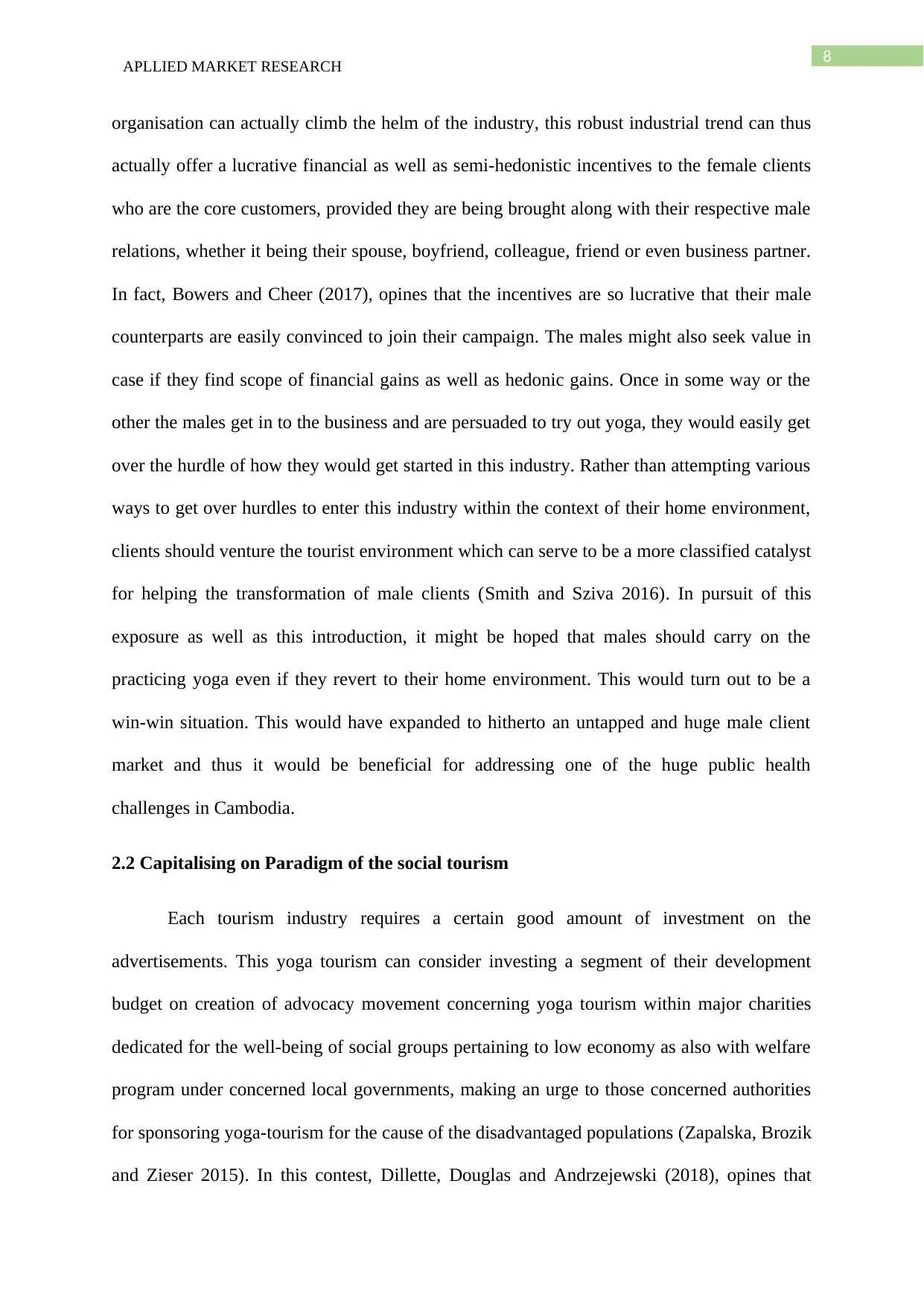
8
APLLIED MARKET RESEARCH
organisation can actually climb the helm of the industry, this robust industrial trend can thus
actually offer a lucrative financial as well as semi-hedonistic incentives to the female clients
who are the core customers, provided they are being brought along with their respective male
relations, whether it being their spouse, boyfriend, colleague, friend or even business partner.
In fact, Bowers and Cheer (2017), opines that the incentives are so lucrative that their male
counterparts are easily convinced to join their campaign. The males might also seek value in
case if they find scope of financial gains as well as hedonic gains. Once in some way or the
other the males get in to the business and are persuaded to try out yoga, they would easily get
over the hurdle of how they would get started in this industry. Rather than attempting various
ways to get over hurdles to enter this industry within the context of their home environment,
clients should venture the tourist environment which can serve to be a more classified catalyst
for helping the transformation of male clients (Smith and Sziva 2016). In pursuit of this
exposure as well as this introduction, it might be hoped that males should carry on the
practicing yoga even if they revert to their home environment. This would turn out to be a
win-win situation. This would have expanded to hitherto an untapped and huge male client
market and thus it would be beneficial for addressing one of the huge public health
challenges in Cambodia.
2.2 Capitalising on Paradigm of the social tourism
Each tourism industry requires a certain good amount of investment on the
advertisements. This yoga tourism can consider investing a segment of their development
budget on creation of advocacy movement concerning yoga tourism within major charities
dedicated for the well-being of social groups pertaining to low economy as also with welfare
program under concerned local governments, making an urge to those concerned authorities
for sponsoring yoga-tourism for the cause of the disadvantaged populations (Zapalska, Brozik
and Zieser 2015). In this contest, Dillette, Douglas and Andrzejewski (2018), opines that
APLLIED MARKET RESEARCH
organisation can actually climb the helm of the industry, this robust industrial trend can thus
actually offer a lucrative financial as well as semi-hedonistic incentives to the female clients
who are the core customers, provided they are being brought along with their respective male
relations, whether it being their spouse, boyfriend, colleague, friend or even business partner.
In fact, Bowers and Cheer (2017), opines that the incentives are so lucrative that their male
counterparts are easily convinced to join their campaign. The males might also seek value in
case if they find scope of financial gains as well as hedonic gains. Once in some way or the
other the males get in to the business and are persuaded to try out yoga, they would easily get
over the hurdle of how they would get started in this industry. Rather than attempting various
ways to get over hurdles to enter this industry within the context of their home environment,
clients should venture the tourist environment which can serve to be a more classified catalyst
for helping the transformation of male clients (Smith and Sziva 2016). In pursuit of this
exposure as well as this introduction, it might be hoped that males should carry on the
practicing yoga even if they revert to their home environment. This would turn out to be a
win-win situation. This would have expanded to hitherto an untapped and huge male client
market and thus it would be beneficial for addressing one of the huge public health
challenges in Cambodia.
2.2 Capitalising on Paradigm of the social tourism
Each tourism industry requires a certain good amount of investment on the
advertisements. This yoga tourism can consider investing a segment of their development
budget on creation of advocacy movement concerning yoga tourism within major charities
dedicated for the well-being of social groups pertaining to low economy as also with welfare
program under concerned local governments, making an urge to those concerned authorities
for sponsoring yoga-tourism for the cause of the disadvantaged populations (Zapalska, Brozik
and Zieser 2015). In this contest, Dillette, Douglas and Andrzejewski (2018), opines that
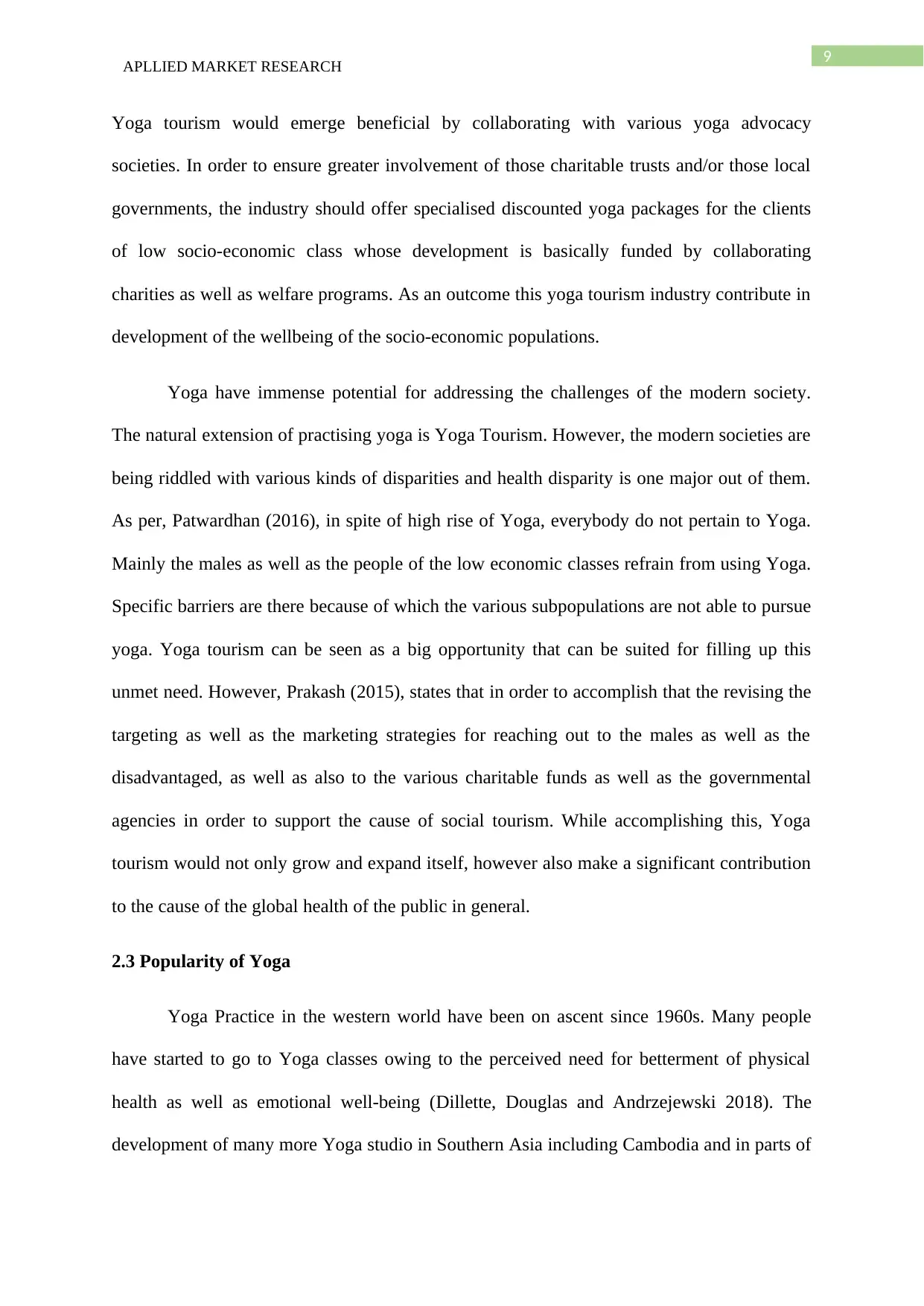
9
APLLIED MARKET RESEARCH
Yoga tourism would emerge beneficial by collaborating with various yoga advocacy
societies. In order to ensure greater involvement of those charitable trusts and/or those local
governments, the industry should offer specialised discounted yoga packages for the clients
of low socio-economic class whose development is basically funded by collaborating
charities as well as welfare programs. As an outcome this yoga tourism industry contribute in
development of the wellbeing of the socio-economic populations.
Yoga have immense potential for addressing the challenges of the modern society.
The natural extension of practising yoga is Yoga Tourism. However, the modern societies are
being riddled with various kinds of disparities and health disparity is one major out of them.
As per, Patwardhan (2016), in spite of high rise of Yoga, everybody do not pertain to Yoga.
Mainly the males as well as the people of the low economic classes refrain from using Yoga.
Specific barriers are there because of which the various subpopulations are not able to pursue
yoga. Yoga tourism can be seen as a big opportunity that can be suited for filling up this
unmet need. However, Prakash (2015), states that in order to accomplish that the revising the
targeting as well as the marketing strategies for reaching out to the males as well as the
disadvantaged, as well as also to the various charitable funds as well as the governmental
agencies in order to support the cause of social tourism. While accomplishing this, Yoga
tourism would not only grow and expand itself, however also make a significant contribution
to the cause of the global health of the public in general.
2.3 Popularity of Yoga
Yoga Practice in the western world have been on ascent since 1960s. Many people
have started to go to Yoga classes owing to the perceived need for betterment of physical
health as well as emotional well-being (Dillette, Douglas and Andrzejewski 2018). The
development of many more Yoga studio in Southern Asia including Cambodia and in parts of
APLLIED MARKET RESEARCH
Yoga tourism would emerge beneficial by collaborating with various yoga advocacy
societies. In order to ensure greater involvement of those charitable trusts and/or those local
governments, the industry should offer specialised discounted yoga packages for the clients
of low socio-economic class whose development is basically funded by collaborating
charities as well as welfare programs. As an outcome this yoga tourism industry contribute in
development of the wellbeing of the socio-economic populations.
Yoga have immense potential for addressing the challenges of the modern society.
The natural extension of practising yoga is Yoga Tourism. However, the modern societies are
being riddled with various kinds of disparities and health disparity is one major out of them.
As per, Patwardhan (2016), in spite of high rise of Yoga, everybody do not pertain to Yoga.
Mainly the males as well as the people of the low economic classes refrain from using Yoga.
Specific barriers are there because of which the various subpopulations are not able to pursue
yoga. Yoga tourism can be seen as a big opportunity that can be suited for filling up this
unmet need. However, Prakash (2015), states that in order to accomplish that the revising the
targeting as well as the marketing strategies for reaching out to the males as well as the
disadvantaged, as well as also to the various charitable funds as well as the governmental
agencies in order to support the cause of social tourism. While accomplishing this, Yoga
tourism would not only grow and expand itself, however also make a significant contribution
to the cause of the global health of the public in general.
2.3 Popularity of Yoga
Yoga Practice in the western world have been on ascent since 1960s. Many people
have started to go to Yoga classes owing to the perceived need for betterment of physical
health as well as emotional well-being (Dillette, Douglas and Andrzejewski 2018). The
development of many more Yoga studio in Southern Asia including Cambodia and in parts of
⊘ This is a preview!⊘
Do you want full access?
Subscribe today to unlock all pages.

Trusted by 1+ million students worldwide
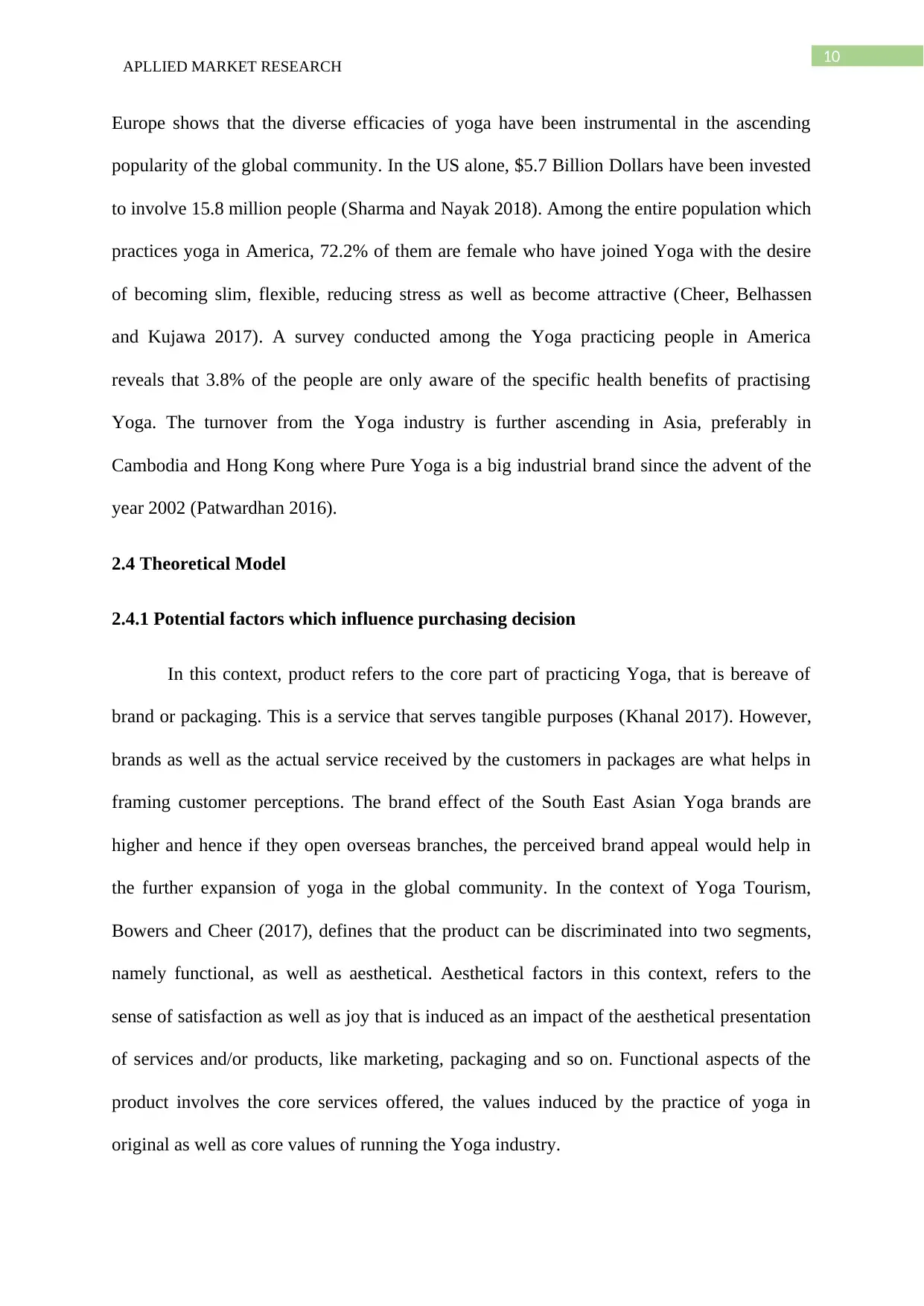
10
APLLIED MARKET RESEARCH
Europe shows that the diverse efficacies of yoga have been instrumental in the ascending
popularity of the global community. In the US alone, $5.7 Billion Dollars have been invested
to involve 15.8 million people (Sharma and Nayak 2018). Among the entire population which
practices yoga in America, 72.2% of them are female who have joined Yoga with the desire
of becoming slim, flexible, reducing stress as well as become attractive (Cheer, Belhassen
and Kujawa 2017). A survey conducted among the Yoga practicing people in America
reveals that 3.8% of the people are only aware of the specific health benefits of practising
Yoga. The turnover from the Yoga industry is further ascending in Asia, preferably in
Cambodia and Hong Kong where Pure Yoga is a big industrial brand since the advent of the
year 2002 (Patwardhan 2016).
2.4 Theoretical Model
2.4.1 Potential factors which influence purchasing decision
In this context, product refers to the core part of practicing Yoga, that is bereave of
brand or packaging. This is a service that serves tangible purposes (Khanal 2017). However,
brands as well as the actual service received by the customers in packages are what helps in
framing customer perceptions. The brand effect of the South East Asian Yoga brands are
higher and hence if they open overseas branches, the perceived brand appeal would help in
the further expansion of yoga in the global community. In the context of Yoga Tourism,
Bowers and Cheer (2017), defines that the product can be discriminated into two segments,
namely functional, as well as aesthetical. Aesthetical factors in this context, refers to the
sense of satisfaction as well as joy that is induced as an impact of the aesthetical presentation
of services and/or products, like marketing, packaging and so on. Functional aspects of the
product involves the core services offered, the values induced by the practice of yoga in
original as well as core values of running the Yoga industry.
APLLIED MARKET RESEARCH
Europe shows that the diverse efficacies of yoga have been instrumental in the ascending
popularity of the global community. In the US alone, $5.7 Billion Dollars have been invested
to involve 15.8 million people (Sharma and Nayak 2018). Among the entire population which
practices yoga in America, 72.2% of them are female who have joined Yoga with the desire
of becoming slim, flexible, reducing stress as well as become attractive (Cheer, Belhassen
and Kujawa 2017). A survey conducted among the Yoga practicing people in America
reveals that 3.8% of the people are only aware of the specific health benefits of practising
Yoga. The turnover from the Yoga industry is further ascending in Asia, preferably in
Cambodia and Hong Kong where Pure Yoga is a big industrial brand since the advent of the
year 2002 (Patwardhan 2016).
2.4 Theoretical Model
2.4.1 Potential factors which influence purchasing decision
In this context, product refers to the core part of practicing Yoga, that is bereave of
brand or packaging. This is a service that serves tangible purposes (Khanal 2017). However,
brands as well as the actual service received by the customers in packages are what helps in
framing customer perceptions. The brand effect of the South East Asian Yoga brands are
higher and hence if they open overseas branches, the perceived brand appeal would help in
the further expansion of yoga in the global community. In the context of Yoga Tourism,
Bowers and Cheer (2017), defines that the product can be discriminated into two segments,
namely functional, as well as aesthetical. Aesthetical factors in this context, refers to the
sense of satisfaction as well as joy that is induced as an impact of the aesthetical presentation
of services and/or products, like marketing, packaging and so on. Functional aspects of the
product involves the core services offered, the values induced by the practice of yoga in
original as well as core values of running the Yoga industry.
Paraphrase This Document
Need a fresh take? Get an instant paraphrase of this document with our AI Paraphraser
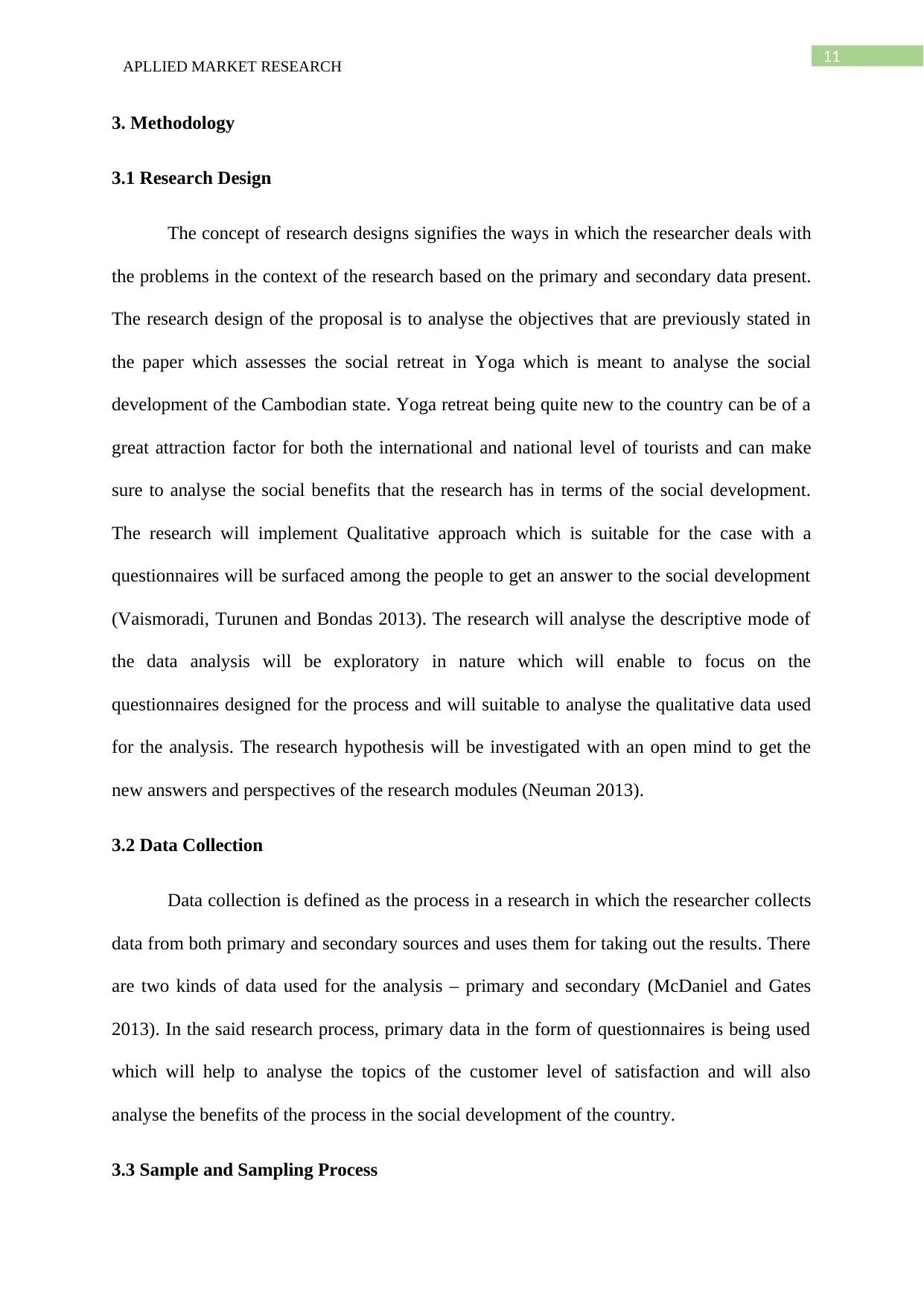
11
APLLIED MARKET RESEARCH
3. Methodology
3.1 Research Design
The concept of research designs signifies the ways in which the researcher deals with
the problems in the context of the research based on the primary and secondary data present.
The research design of the proposal is to analyse the objectives that are previously stated in
the paper which assesses the social retreat in Yoga which is meant to analyse the social
development of the Cambodian state. Yoga retreat being quite new to the country can be of a
great attraction factor for both the international and national level of tourists and can make
sure to analyse the social benefits that the research has in terms of the social development.
The research will implement Qualitative approach which is suitable for the case with a
questionnaires will be surfaced among the people to get an answer to the social development
(Vaismoradi, Turunen and Bondas 2013). The research will analyse the descriptive mode of
the data analysis will be exploratory in nature which will enable to focus on the
questionnaires designed for the process and will suitable to analyse the qualitative data used
for the analysis. The research hypothesis will be investigated with an open mind to get the
new answers and perspectives of the research modules (Neuman 2013).
3.2 Data Collection
Data collection is defined as the process in a research in which the researcher collects
data from both primary and secondary sources and uses them for taking out the results. There
are two kinds of data used for the analysis – primary and secondary (McDaniel and Gates
2013). In the said research process, primary data in the form of questionnaires is being used
which will help to analyse the topics of the customer level of satisfaction and will also
analyse the benefits of the process in the social development of the country.
3.3 Sample and Sampling Process
APLLIED MARKET RESEARCH
3. Methodology
3.1 Research Design
The concept of research designs signifies the ways in which the researcher deals with
the problems in the context of the research based on the primary and secondary data present.
The research design of the proposal is to analyse the objectives that are previously stated in
the paper which assesses the social retreat in Yoga which is meant to analyse the social
development of the Cambodian state. Yoga retreat being quite new to the country can be of a
great attraction factor for both the international and national level of tourists and can make
sure to analyse the social benefits that the research has in terms of the social development.
The research will implement Qualitative approach which is suitable for the case with a
questionnaires will be surfaced among the people to get an answer to the social development
(Vaismoradi, Turunen and Bondas 2013). The research will analyse the descriptive mode of
the data analysis will be exploratory in nature which will enable to focus on the
questionnaires designed for the process and will suitable to analyse the qualitative data used
for the analysis. The research hypothesis will be investigated with an open mind to get the
new answers and perspectives of the research modules (Neuman 2013).
3.2 Data Collection
Data collection is defined as the process in a research in which the researcher collects
data from both primary and secondary sources and uses them for taking out the results. There
are two kinds of data used for the analysis – primary and secondary (McDaniel and Gates
2013). In the said research process, primary data in the form of questionnaires is being used
which will help to analyse the topics of the customer level of satisfaction and will also
analyse the benefits of the process in the social development of the country.
3.3 Sample and Sampling Process
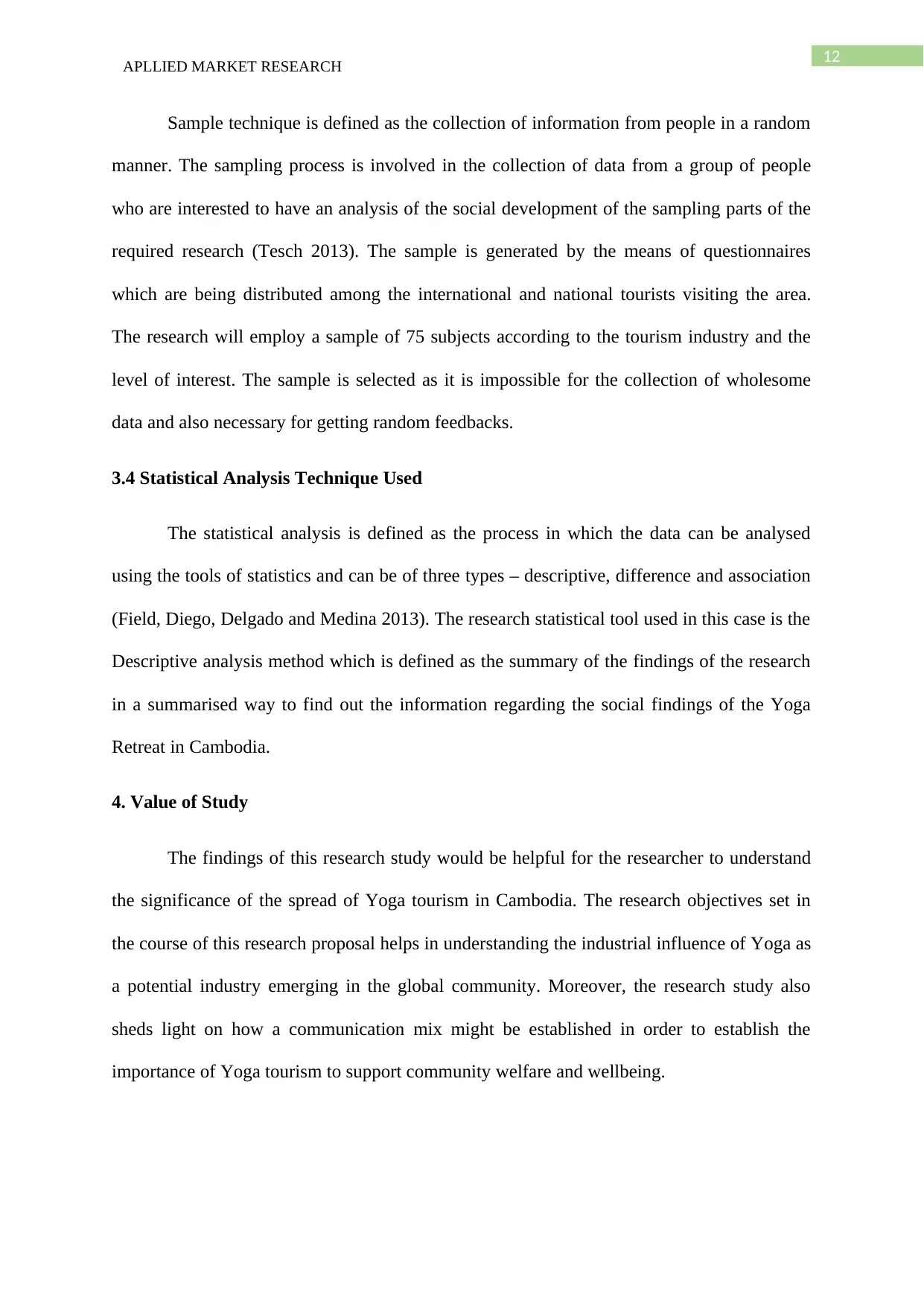
12
APLLIED MARKET RESEARCH
Sample technique is defined as the collection of information from people in a random
manner. The sampling process is involved in the collection of data from a group of people
who are interested to have an analysis of the social development of the sampling parts of the
required research (Tesch 2013). The sample is generated by the means of questionnaires
which are being distributed among the international and national tourists visiting the area.
The research will employ a sample of 75 subjects according to the tourism industry and the
level of interest. The sample is selected as it is impossible for the collection of wholesome
data and also necessary for getting random feedbacks.
3.4 Statistical Analysis Technique Used
The statistical analysis is defined as the process in which the data can be analysed
using the tools of statistics and can be of three types – descriptive, difference and association
(Field, Diego, Delgado and Medina 2013). The research statistical tool used in this case is the
Descriptive analysis method which is defined as the summary of the findings of the research
in a summarised way to find out the information regarding the social findings of the Yoga
Retreat in Cambodia.
4. Value of Study
The findings of this research study would be helpful for the researcher to understand
the significance of the spread of Yoga tourism in Cambodia. The research objectives set in
the course of this research proposal helps in understanding the industrial influence of Yoga as
a potential industry emerging in the global community. Moreover, the research study also
sheds light on how a communication mix might be established in order to establish the
importance of Yoga tourism to support community welfare and wellbeing.
APLLIED MARKET RESEARCH
Sample technique is defined as the collection of information from people in a random
manner. The sampling process is involved in the collection of data from a group of people
who are interested to have an analysis of the social development of the sampling parts of the
required research (Tesch 2013). The sample is generated by the means of questionnaires
which are being distributed among the international and national tourists visiting the area.
The research will employ a sample of 75 subjects according to the tourism industry and the
level of interest. The sample is selected as it is impossible for the collection of wholesome
data and also necessary for getting random feedbacks.
3.4 Statistical Analysis Technique Used
The statistical analysis is defined as the process in which the data can be analysed
using the tools of statistics and can be of three types – descriptive, difference and association
(Field, Diego, Delgado and Medina 2013). The research statistical tool used in this case is the
Descriptive analysis method which is defined as the summary of the findings of the research
in a summarised way to find out the information regarding the social findings of the Yoga
Retreat in Cambodia.
4. Value of Study
The findings of this research study would be helpful for the researcher to understand
the significance of the spread of Yoga tourism in Cambodia. The research objectives set in
the course of this research proposal helps in understanding the industrial influence of Yoga as
a potential industry emerging in the global community. Moreover, the research study also
sheds light on how a communication mix might be established in order to establish the
importance of Yoga tourism to support community welfare and wellbeing.
⊘ This is a preview!⊘
Do you want full access?
Subscribe today to unlock all pages.

Trusted by 1+ million students worldwide
1 out of 20
Related Documents
Your All-in-One AI-Powered Toolkit for Academic Success.
+13062052269
info@desklib.com
Available 24*7 on WhatsApp / Email
![[object Object]](/_next/static/media/star-bottom.7253800d.svg)
Unlock your academic potential
Copyright © 2020–2025 A2Z Services. All Rights Reserved. Developed and managed by ZUCOL.



